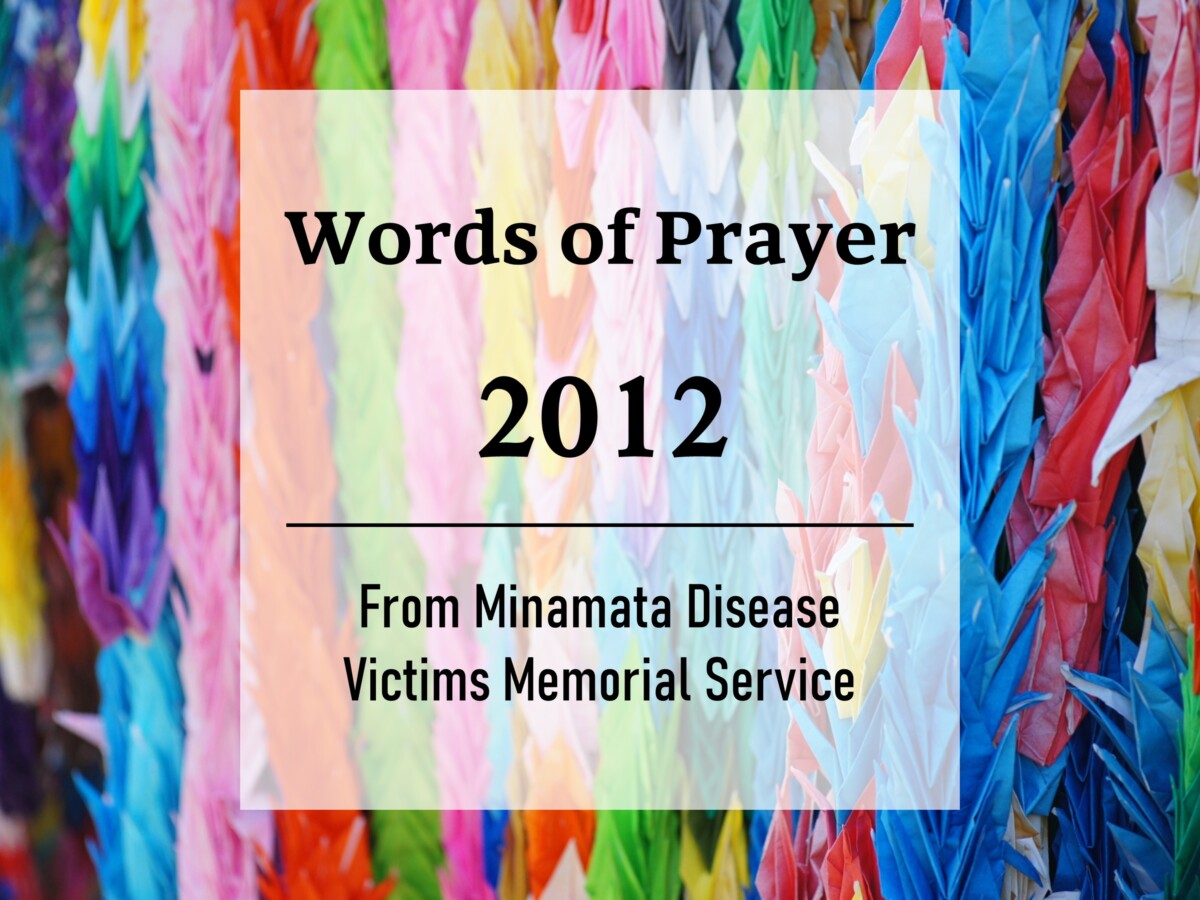
祈りの言葉2012年/永本 賢二
水俣病患者・遺族代表 「祈りの言葉」
Minamata Disease Patient and Bereaved Family Representative’s “Words of Prayer”
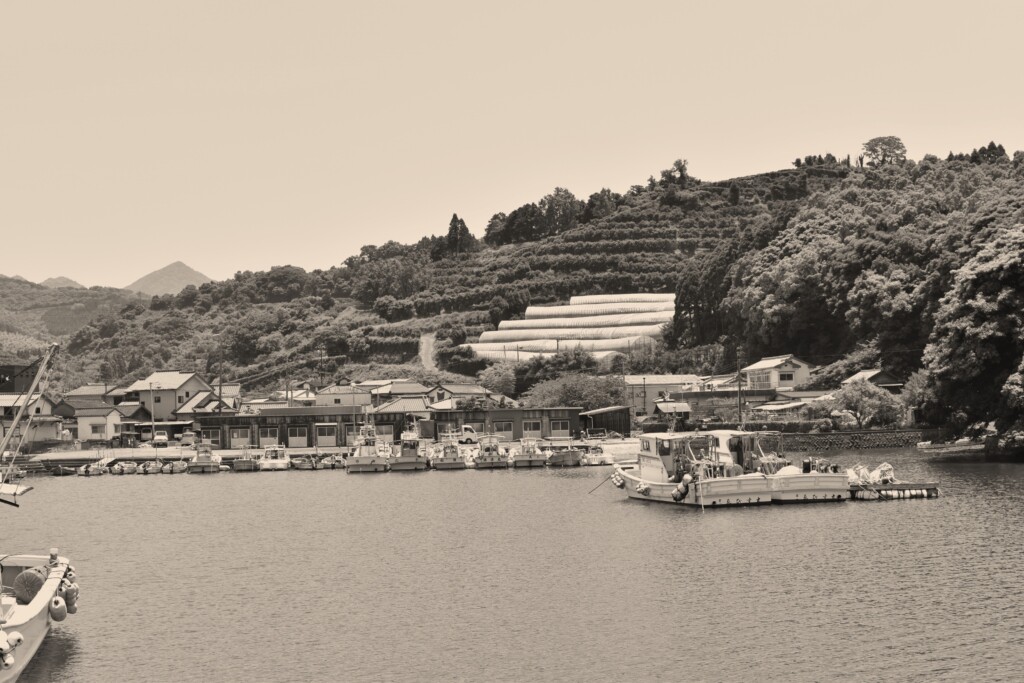
私は、昭和34年9月1日に、生まれました。水俣病の原因が工場排水にあるとチッソが気付いた時、水俣病が公式確認されて3年目です。この事実を知った時、私より後から生まれてくる胎児性の仲間のためにも、タイムスリップしスーパーマンになって排水口を止めたかったです。私の家では、昭和23年と24年に続けて兄が生まれました。2人ともすぐに亡くなり昭和27年と30年に姉が生まれました。そして、私は待望の男の子でした。祖母は、バンザイ、バンザイと大喜びしてくれたそうです。でも、私の成長は2人の姉とは少し違っていました。痺れや痛みで泣いてばかりで、1歳になっても歩くことができずにずいぶん家族は心配しました。風呂上がりには姉達がマッサージしてくれたのを覚えています。当時、病名も原因も不明とされていました。
I was born on September 1, 1959. It was three years after the official confirmation of Minamata disease, when Chisso Corporation realized that the cause of Minamata disease was the waste water from their factories. When I learned this fact, I wished I had been able to go back in time and become Superman to stop the drainage for the sake of the friends who were born later than I so that they wouldn’t have to suffer from fetal Minamata disease. My oldest brother was born in 1948 and the second in 1949. But both of them died soon after their birth. The oldest sister was born in 1952 and the second in 1955. And I was the long-awaited boy. My grandmother was overjoyed and said, “Banzai, banzai!” But my growth was a little different from my two older sisters’. I was always crying because of the numbness and pain, and I couldn’t walk even after I turned one. This made my family very worried. I remember my sisters gave me massages after I took a bath. At that time, neither the name nor the cause of the disease were known.
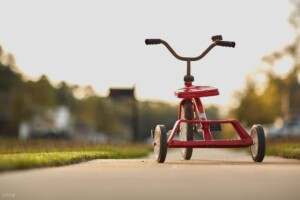 父はチッソ工場の労働者で、昭和37年7月の安賃闘争を第一組合で闘いました。父は、闘いの象徴でもある赤い鉢巻を私の頭に巻いて、拳をあげた「ガンバロー」のポーズをとらせてくれました。ちょっと照れくさく、苦手でした。語り部の時に皆さんに見ていただく家の中で三輪車に乗った3歳ぐらいの私の写真がそれです。 歩くことができなかった私に3輪車は車イスの代わりでした。同じ、昭和37年、世界で初めて胎児性水俣病が確認され、私も、間もなく認定されました。それは、父が懸命になってチッソに訴えてくれたお陰と母に聞かされ、『お父さんありがとう』と、感謝の言葉が出ました。父は大好きな会社を訴えることが、とても辛かったと思います。
父はチッソ工場の労働者で、昭和37年7月の安賃闘争を第一組合で闘いました。父は、闘いの象徴でもある赤い鉢巻を私の頭に巻いて、拳をあげた「ガンバロー」のポーズをとらせてくれました。ちょっと照れくさく、苦手でした。語り部の時に皆さんに見ていただく家の中で三輪車に乗った3歳ぐらいの私の写真がそれです。 歩くことができなかった私に3輪車は車イスの代わりでした。同じ、昭和37年、世界で初めて胎児性水俣病が確認され、私も、間もなく認定されました。それは、父が懸命になってチッソに訴えてくれたお陰と母に聞かされ、『お父さんありがとう』と、感謝の言葉が出ました。父は大好きな会社を訴えることが、とても辛かったと思います。
My father worked at Chisso plant and fought for the first union in the stable wage struggle in July 1962. My father wrapped a red headband, a symbol of the struggle, around my head and made me raise my fist in the air in a “let’s do our best together” pose. I was a little embarrassed and not very good at it. The picture which I always show you during the storytelling is the one that captured me with that pose at about 3 years old on a tricycle in the house. I could not walk, so the tricycle was a substitute for a wheelchair. In 1962, the world’s first case of fetal Minamata disease was confirmed, and I was soon recognized as having the disease. My mother told me that it was because of my father’s efforts in appealing to Chisso. I expressed my gratitude by saying, “Thank you, father”. I think it was very hard for my father to sue the company he loved.
小学校5年で父は、亡くなりました。当時の父の思い出は、3交代の合間に船を持ち漁も大好きで、チッソも大好きで、働くことを誇りにしていました。私もチッソが大好きでした。クレーンや煙突の煙を見ると、チッソもがんばってるなと励まされました。小学校でも、中学校でも 水俣病患者で障がいがあることで、いじめられました。その辛さを、チッソの風景が救ってくれました。今はクレーンもないし、残っているのはでっかい倉庫だけ。それを絶対なくしてほしくない。心の中だけの梅戸港にしたくないです。これからのことを考える時、一番不安なのはいつ自分も車椅子生活になるのかなということです。先輩の胎児性患者も私より若い胎児性患者も、急激に車椅子になってしまいました。今、埋め立て地のお地蔵さんまで訓練だと思って歩いていますが、いつまでもずっと歩きたいです。
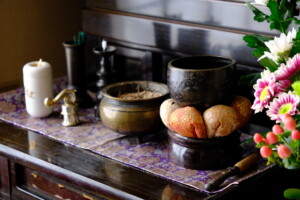 My father passed away when I was in the fifth grade. In addition to working three shifts at Chisso, my father had a boat and went fishing. He loved fishing and loved also Chisso. He was proud to work. I loved Chisso too. When I saw the smoke from the cranes and chimneys, I used to be encouraged that Chisso was working hard as well. In elementary school and junior high school, I was bullied because I was a Minamata disease patient and had a disability. The scenery of Chisso saved me from that pain. Now there are no cranes, and all that is left is a big warehouse. I don’t want that to be lost. I don’t want it to be just a port only in my memory. When I think about my future, the thing that worries me the most is when I will be confined to a wheelchair. Both my senior fetal patients and my younger fetal patients have rapidly become wheelchair-bound. I often walk to the Jizos(guardian deity of children) standing on the reclaimed land as a training. I want to walk like this forever and ever.
My father passed away when I was in the fifth grade. In addition to working three shifts at Chisso, my father had a boat and went fishing. He loved fishing and loved also Chisso. He was proud to work. I loved Chisso too. When I saw the smoke from the cranes and chimneys, I used to be encouraged that Chisso was working hard as well. In elementary school and junior high school, I was bullied because I was a Minamata disease patient and had a disability. The scenery of Chisso saved me from that pain. Now there are no cranes, and all that is left is a big warehouse. I don’t want that to be lost. I don’t want it to be just a port only in my memory. When I think about my future, the thing that worries me the most is when I will be confined to a wheelchair. Both my senior fetal patients and my younger fetal patients have rapidly become wheelchair-bound. I often walk to the Jizos(guardian deity of children) standing on the reclaimed land as a training. I want to walk like this forever and ever.
まだまだ水俣病は終っていません。苦しんでいる患者さんたちを救えないのかなと思います。患者さん達もがんばってほしいし、チッソや国や県はどうするのかな、終わらしてはいけないです。終わってない水俣病患者の気持ちを本当にわかってほしい。車椅子の人たちの気持ちをチッソの人たちはわかってほしい。ちゃんと水俣の子どもたちには「水俣出身です」っていってほしい。9月に子どもたちが語り部を聞いてくれた時、誕生日だったので、校歌をこどもたちが歌ってくれてうれしかったです。
Minamata disease is not over yet. I wonder why patients who are suffering from the disease are still not saved. I want the patients to do their best, and I don’ know what Chisso, the government and the prefecture will do, but Minamata disease case is not yet to be closed. I want people to really understand the feelings of Minamata disease patients who still don’t think their struggles for dignity are finished. I want the people of Chisso to really understand the feelings of the patients in wheelchairs. I want the children of Minamata to proudly say that they are from Minamata. In September, I told children my story and they listened to me. It happened to be my birthday, and they sang their school song for me. I was happy to hear them sing.
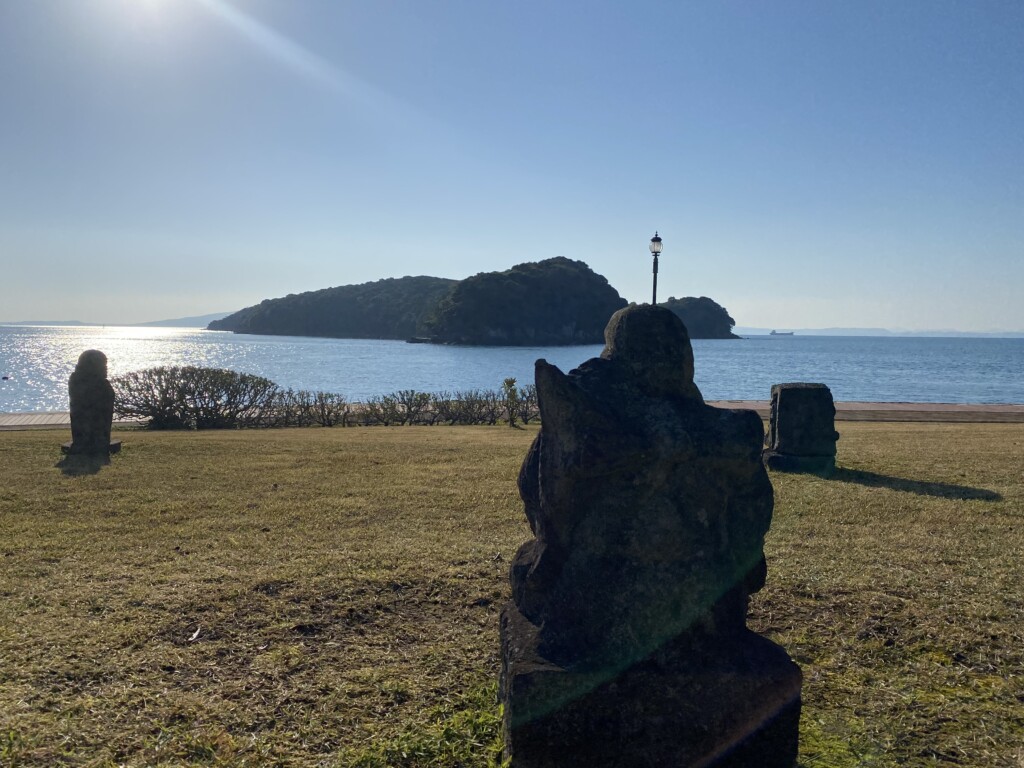
昨年の3月11日、東日本大震災で多くの生命が奪われ、津波に襲われた町や村が一瞬のうちにメチャクチャにされた光景をテレビから見せていただき心が痛みました。子ども達のことを考えると、水俣病に苦しんだ小さい頃と重なって涙が止まりませんでした。ほっとはうすの仲間と去年の水俣病を伝える活動の中で、福島原子力発電所の放射能から子どもを守るため九州に避難をしているお母さん達、放射能を計測し、必死で子どもたちを守ろうとしているお父さんにも出会いました。改めて、水俣と福島のつながりを考え、水俣病事件の教訓が、少しも学ばれていないことを知りました。
On March 11 last year, the Great East Japan Earthquake took many lives, and it was heartbreaking to see the towns and villages destroyed by tsunami on TV. I couldn’t stop crying because my memory of my childhood when I suffered from Minamata disease overlapped with the children affected in Tohoku. Through the activities with the Hotto House members to tell the story of Minamata disease, we met last year the mothers who evacuated to Kyushu to protect their children from radiation from the Fukushima nuclear power plant, and the fathers who were measuring radiation and desperately trying to protect their children. Once again, I thought about what Minamata had in common with Fukushima and realized that the lessons from the Minamata disease incident had not been learned at all.
子ども達を放射能から守るためにも、水俣病を伝える活動を続けていきたいです。そのことが、水俣病で犠牲になった多くの生命を無駄にさせないことです。 今あらためて、そのことをお誓いし、東日本大震災で奪われた人間だけでない、小さな生命たち、魚、虫、鳥、すべての失われた生命の御冥福をお祈りいたします。最後に、水俣病で奪われた全ての生命に哀悼の誠をささげ、心より御冥福をお祈りいたします。
In order to protect children from radiation, I would like to continue my activities to tell people about Minamata disease. This is the only way to ensure that the lives of the many victims of Minamata disease are not wasted. I would like to reiterate my pledge and pray for the repose of the souls of not only human beings lost in the Great East Japan Earthquake, but also all the small lives such as fish, insects, birds, and all other lost lives. Finally, I would like to offer my sincere condolences to all lives lost due to Minamata disease and pray for the repose of their souls.
平成24年5月1日
May 1, 2012
水俣病患者・遺族代表 永本賢二
Kenji Nagamoto,
Representative of Minamata Disease Patients and Bereaved Families
水俣病資料館ウェブサイトより
Reference Minamata City Minamata Disease Museum Website
翻訳 水俣インパクト translated by minamata impact
コメント ( 0 )
トラックバックは利用できません。











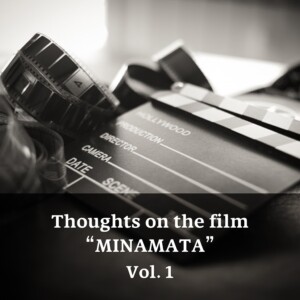
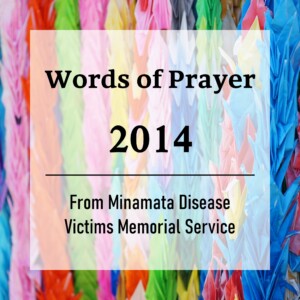
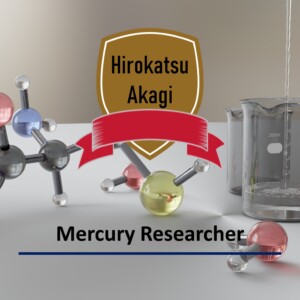
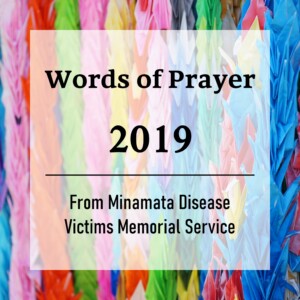
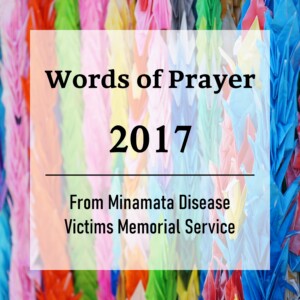
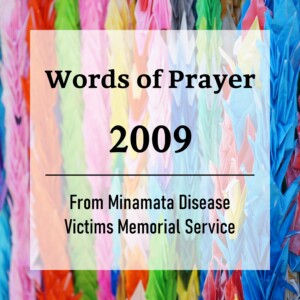
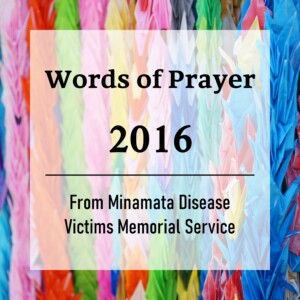
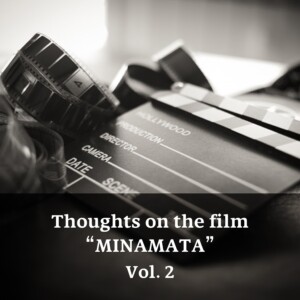
この記事へのコメントはありません。